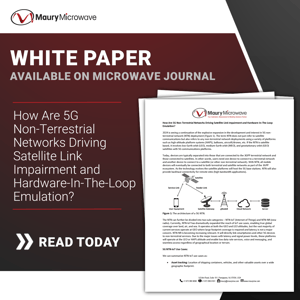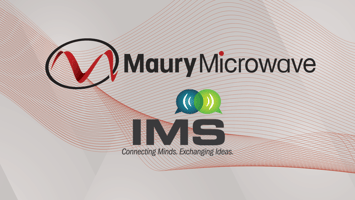It’s that time of year again for the IEEE MTT-S International Microwave Symposium (IMS). Here’s a...
Why Is Channel Emulation Key for Deploying 5G Non-terrestrial Networks Successfully?
Relying solely on traditional ground-based infrastructure has limitations, particularly when providing coverage to remote or underserved areas. 5G non-terrestrial networks (NTN) enhance the capabilities of terrestrial systems by integrating non-terrestrial platforms to deliver reliable and extensive wireless connectivity across diverse environments. This blog post will review different types of non-terrestrial platforms and the importance of channel emulation in ensuring NTN meet required performance standards.
Non-terrestrial Platforms
5G NTN can be designed to use a variety of airborne and space-based platforms to extend coverage. Platform types include:
Satellites: Satellites are pivotal in extending the reach of terrestrial network infrastructure. Orbital path characteristics are used to differentiate satellites into three common groups – low-Earth orbit (LEO), medium-Earth orbit (MEO), and geostationary orbit (GEO).
- LEO: Typically operating at an altitude of no more than 1,200 miles, LEO satellites offer high-speed, low latency data transmission due to their proximity to Earth. The high velocity of satellites in LEO limits coverage range as well as increases Doppler shift and handovers.
- MEO: Operating in the range between LEO and GEO, MEO satellites provide balanced characteristics in terms of coverage, latency, Doppler shift, handovers, and path loss.
- GEO: GEO satellites operate at significant distances from Earth’s surface (just above 22,000 miles), providing a wide coverage area and long operational lifespan. At the same time, GEO satellite signals often experience extensive delays and high path loss.
High-altitude platforms (HAPS): From balloons to solar-powered airborne systems, HAPS are typically deployed in the stratosphere positioned around 12 miles above Earth’s surface. Onboard, specialized instruments enable HAPS to deliver extended communications coverage for 5G NTN.
Aircraft and drones: Aircraft provide communications support over a wide service area while drones can serve as dynamic, highly flexibly tools for quick-deployment scenarios, such as localized emergency tasks.
The Importance of Channel Emulation
As an RF signal travels between a transmitter and receiver, various impairments are added to the communication path. Channel emulators are used to simulate real-world conditions, enabling engineers to adjust and optimize designs in a controlled environment to ensure deployed systems operate as planned.
Used over vast distances within dynamic environments, NTN face unique challenges (e.g., significant time delay, Doppler shifts, etc.) compared to terrestrial-based networks, which primarily encounter multi-path fading. For background, multi-path fading refers to the multiple signal paths to a receiver, caused by reflections or refractions off various obstacles, such as buildings, mountains, and bodies of water. With repair and servicing often not possible, practical, or in a reasonable price range, advanced channel emulators that meet the specific needs of NTN, such as the Maury Microwave ACE9600 Advanced Channel Emulator of the dBm product line, are vital for comprehensive pre-deployment testing and performance analysis.
ACE9600 Advanced Channel Emulator
The Maury Microwave Advanced Channel Emulator (ACE) of the dBm product line is the most advanced non-terrestrial RF channel emulation solution to date. The emulated impairments include delay, signal Doppler, attenuation, phase offset, AWGN, frequency hopping, payload and multipath fading. The instrument can house up to four 600 MHz instantaneous bandwidth channels. Impairment emulation can be set to fixed values in Static mode, or continuously changed in real time in Dynamic mode without any phase discontinuities.

Channel emulators simulate a range of impairments to replicate NTN deployment conditions accurately, including:
- Time delays: Long transmission distances increase the time it takes a signal to travel from the transmitter to the receiver and back, referred to as the roundtrip time delay. Since satellites often experience time delay variations, emulators must be able to produce phase-continuous time delay for the specific orbit of focus.
- Doppler shift: Satellites, especially those in LEO, operate at high relative velocities that cause high Doppler shift, where the relation motion between one or more antennas (e.g., a moving satellite over a stationary ground receiver) alters the frequency and impacts signal quality.
- Signal bandwidth: NTN have various bandwidth requirements. Emulators that can process significant continuous signal bandwidth ensure an accurate representation of signal characteristics.
- Path loss and atmospheric scintillation: Signal power can weaken as it travels long distances through atmospheric disturbances. It’s therefore necessary for channel emulators to reproduce the fluctuations in phase and signal strength caused by the Earth's atmosphere.
- Hardware-in-the-loop (HITL) impairments: Hardware-induced distortions from ground station and satellite payload components can degrade signal quality. Important impairments for channel emulators during HITL testing include signal compression, intermodulation distortion, AM/PM distortion, phase noise, group delay slope and amplitude slope, and passband notching to simulate different countries regulatory spectrum requirements.
A Deep Dive into 5G NTN & Channel Emulators
Available now on Microwave journal is the white paper, “How Are 5G Non-Terrestrial Networks Driving Satellite Link Impairment and Hardware-In-The-Loop Emulation?” The white paper covers the distinctions between two prominent 5G NTN subcategories – 5G NTN-IoT and 5G NTN-NR – along with a summary of 3GPP releases that permit wireless connectivity above the Earth’s surface, the development of lunar NTN communications, and key 5G NTN partnerships. In addition, the paper highlights the importance of using channel emulators, such as the ACE9600, to properly evaluate electromagnetic and environmental effects and hardware-generated impairments on the signal path before deployment. Download the white paper today to learn how to maximize the performance of 5G NTN.



